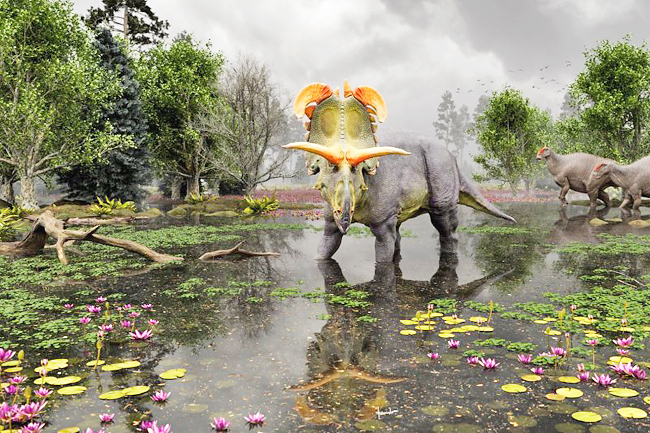UPI – American scientists announced last Thursday the discovery of a new species of horned dinosaur which at 11,000 pounds and 22 feet long is the largest centrosaurine ever found in North America and roamed the swamps of what is now the badlands of Montana in the late Cretaceous period 78 million years ago.
The new dinosaur was identified and subsequently christened Lokiceratops rangiformis by Colorado State University affiliate faculty member Joseph Sertich and Utah University Professor Mark Loewen due to an ostentatious set of curving blade-like horns on the rear of its “frill” and an asymmetrical horn that bear comparison with the antlers of caribou, Colorado State University said in a news release.
The find, detailed in a peer-reviewed study published in the scientific journal PeerJ, is named for Loki, a mythological human-like Norse deity with horns and its Triceratops descendant and translates, approximately, to “Loki’s horned face that looks like a caribou”.
“The dinosaur now has a permanent home in Denmark, so we went with a Norse deity, and in the end, doesn’t it just really look like Loki with the curving blades?” said Loewen, co-author and palaeontologist at the Natural History Museum of Utah in Salt Lake City.
Speaking as a replica was put on display to the public at the museum, co-author and Smithsonian Tropical Research Institute palaeontologist Sertich said: “It’s one of those stories with a happy ending, where it didn’t go to somebody’s mansion. It ended up in a museum, where it will be preserved forever so people can study it and enjoy visiting it.”
The original is on permanent display at the Museum of Evolution on the Danish island of Lolland, south of Copenhagen, Denmark, to which both men are scientific consultants.
Sertich and Loewen reconstructed the head and frill/horns array from dinner plate-sized and smaller-sized bone fragments found in 2019 in northern Montana, just south of the Canadian border.





